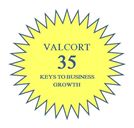Value Matters. Measure It.
Valcort 35 Keys to Business Growth: #14. Consistently measure all marketing and sales activities and your progress toward achieving your  vision, and communicate the results with the company regularly.
vision, and communicate the results with the company regularly.
How would you define personal success? What will make your life a success? These are great questions to ask yourself. Perhaps it’s raising healthy and happy children, having fulfilling relationships, being authentic in conversations, writing a book, loving a career, or adhering to the call of your faith. Whatever you put on your list, these are, ultimately, what you value.
How would you define business success? Many organizations focus only on measuring revenues and profitability, and miss the opportunity to engage the staff in what really matters—purpose, and making a difference in the lives of consumers. How would you measure this? You may have a solid list of criteria. We believe you can go a long way toward a healthy, growing business when you can articulate your vision and measure it along five fundamental standards:
1. Alignment: When your business’s practices and products align with your vision and what you and your colleagues value personally.
When you look at your livelihood, business, corporation, areas of service—into which you pour decades of your life—the corporate expression of value and vision will either bring satisfaction (if it aligns with what you value personally), or frustration (if it doesn’t). How can a leader or any employee contribute to the alignment of values? It takes work! These five steps will give you a start.
- Hiring — Make every effort to select people who already embrace your values and vision.
- Knowledge – Make sure your employees, volunteers and members of your board know your values and your vision — what you’re trying to achieve — and can recognize behavior and decisions that are consistent or inconsistent with these.
- Outside and safe perceptions – Create a discipline and a regular process to seek outside, anonymous opinions (or employee opinions through anonymous surveys or focus groups held off-site and facilitated by outsiders) about what are the real values and culture of the company. Questions should focus on identifying what the demonstrated values and priorities are versus what is stated.
- Behavior – Are your corporate decisions consistent with your values? Does employee behavior align with your values? For example, if health and fitness is one of your values, you might measure the number of employees who get an annual physical or workout in the company gym. If one of your values is work/life balance, you might measure how many employees work while they are on vacation.
- Reinforcement — Are your key values present in your evaluation system? What you reward through advancement, money and power is a strong measure of what you value. If your value is accountability, you might track how many employees are disciplined or fired for poor performance.
The Valcort Pulse-Values Survey paints a picture of the strength of your organization’s culture, where values and behaviors that drive growth are breaking down, and provides positive recommendations to address them.
2. Distinctiveness: When your business provides goods or services that customers recognize as unique, worthwhile and valuable to them—that makes a difference to them in some way.
This value is summarized in a statement or proposition that should be based on an accurate understanding of customers’ needs, frustrations and buying habits, as well as a sharp view of your current competitors, of trends in the marketplace, and of other conditions that may create opportunities. This requires carefully designed research and broad participation within your company, as well as discussions throughout your industry. How do you know which features and services are most important to your customers? Ask them–starting with your most important customers and key accounts. It is valuable to have a third party help with your research because too often you’ll miss many important observations and differentiation, because you’re in the “trees.” (We can help take a fresh, unbiased look, and uncover assets you many miss.)
3. Agility: When your business can make progress in accomplishing your vision and make customers’ lives easier or better in the context of constant change, innovation, improvement and re-invention.
Agility is not just the ability to make a profit in the short run; it’s the ability to sustain growth and make progress on your vision through changing times. As consultant Michael Hugos points out:
“True agility is self-sustaining, not self-consuming. Companies can always get a short-term boost to profit margins by cutting headcount, reducing customer service, squeezing suppliers for lower prices, and deferring repairs and improvements to infrastructure. But that is self-consuming, like spending down your bank account. It’s not agile because it isn’t sustainable; it does not create or renew; it only uses up.”
Business agility is greatest when your people can clearly see what’s going on in their area of operation, and if they have the motivation to respond appropriately, Hugos says. The effect of this visibility and motivation will be multiplied and magnified by the training people get. The better people are trained, the greater the results will be.
Based on these criteria, how do your measure your company’s agility? Visibility can be measured by the technology and procedures a company uses to collect, store, disseminate and display information. Motivation can be measured by the incentives and authority people are given to make decisions and act to achieve company objectives. Training can be measured on the basis of how peoples’ skills are used for visibility, for making good decisions, and acting effectively to achieve the vision.
4. Knowledge: When you can determine not only what is and is not working, but also why.
The true measure of future ability to succeed is not sales results or the number of customers, but how much you’re learning about your clients, your products, your market, your business and yourself. Obviously it’s great if you’re acquiring customers, but it’s even better to learn why those customers signed on and why others chose not to, and to get feedback on what parts of your offering need improvement. So in addition to metrics, ask yourself how much you’ve learned. To get to the “why,” conduct robust customer research that includes both quantitative measures and good one-on-one interviews with customers from all segments and levels of involvement. (We can help)
5. Profitability: When your business provides the level of profitability that fuels investment in growth and that is valued by the corporate leaders, you and your co-workers, and investors/stockholders.
Profitability is more easily understood and measured than other value standards. A business that is not profitable cannot survive. Conversely, a business that is highly profitable has the ability to reward its owners with a large return on their investment. Increasing profitability is, obvioulsy, one of the most important tasks of the business managers.
While profitability is measured with an income statement, that statement has very little to say about the other strands of the corporate fabric, the weaving of which will contribute to the ongoing health and growth of the business and its people, and its ability to accomplish its vision over the long haul.
By measuring all five of these standards –your alignment, distinctiveness, knowledge, agility and profitability–you develop a clearer understanding of your current value, and the opportunities to grow and achieve your vision in the days ahead.
____________________________________
The Valcort 35 Keys to Business Growth. Over many years and hundreds of client relationships and strategic marketing opportunities, we have established the Valcort 35 Keys to Business Growth, best practices that build trust, align values with products and practices, and create organic growth. We are exploring these 35 practices, one at a time, on these pages. Find them all, as they’re introduced, here.
Tags: marketing measurement, Valcort 35 Keys to Growth, value, values






